Van Gogh Museum Journal 1996
(1996)– [tijdschrift] Van Gogh Museum Journal–
[pagina 16]
| |
[The Museum Mesdag in perspective] fig. 1
Mesdag by a window in his house, c. 1913, Amsterdam, Van Gogh Museum, Museum Mesdag Archive | |
[pagina 17]
| |
The Museum Mesdag: a short history
| |
[pagina 18]
| |
house was sold at auction in New York,Ga naar voetnoot3 but the plan to reline the walls of his museum with fabric had to be abandoned, and ‘paper was used instead in order to keep costs to a minimum.’ In the annual report for 1922 one reads of an operation to tone down the character of the original decoration. The painted wainscotting was given a layer of mat varnish, ‘with the result that the gilded borders, which had been too shiny, took on a more muted tone, making for a more subdued overall impression.’ The director in these straitened times was the artist Willy Martens, who had succeeded deputy director Fenna van Calcar in 1911, and then Mesdag himself in 1915. When the walls were relined, Martens took the opportunity to rehang some of the pictures, ‘thus showing them to better advantage.’ Apart from that, his efforts were limited to giving guided tours and urging artists to come and copy in the museum. | |
Steenhoff's interventionIn 1924, Martens was succeeded by Willem Steenhoff, who had become surplus to requirements after a reorganisation of the Rijksmuseum in Amsterdam. Steenhoff had been responsible for bringing Impressionist art into the Rijksmuseum and had, incidentally, helped to install the major Van Gogh retrospective of 1905 in Amsterdam's Stedelijk Museum. He immediately set about a ‘general rearrangement - and pruning - of the collection of paintings.’ He removed so many works from the permanent display that new storage space was needed, and in 1925 half of the studio that Mesdag had built for Martens in the garden was used for these reserves. Admissions that year rose slightly to 8,227. Steenhoff's actions, however responsible by the prevailing standards of museum management, ran into heavy opposition from Mesdag's family, who demanded strict observance of the conditions of donation.Ga naar voetnoot4 Article 3c of the deed of gift obliged the state ‘to make as few alterations as possible to the positions of the paintings and works of art.’ Steenhoff's fiercest opponent was Sam van Houten, a former government minister and Mesdag's brother-in-law. He took serious exception to the proposed exhibition of the Van Gogh collection in the Museum Mesdag, for which V.W. van Gogh had already given his permission. Despite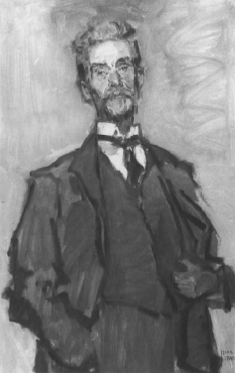 fig. 2
Isaac Israëls, Portrait of Willem Steenhoff, The Hague, Museum Mesdag (on loan from The Hague, Gemeentemuseum) support for Steenhoff from Pulchri Studio, the Hague artists' society, the incumbent Minister of Home Affairs bowed to the pressure brought by Mesdag's heirs and ordered Steenhoff to restore the original hanging and even reverse the changes made by Martens. For the first time the aloof, official tone of the annual report wavered, allowing Steenhoff's annoyance and frustration to show through. Under the heading ‘Condition of the collection,’ he wrote with barely suppressed indignation ‘The museum had a turbulent year in 1926. Very soon after taking up my post I came to the conclusion that a general rearrangement - and pruning - of the paintings was extremely desirable, first and foremost in order to make the nucleus of this magnificent and, for our country, unique collection stand out more clearly, and also because | |
[pagina 19]
| |
a more well-considered arrangement would provide a more harmonious and instructive survey of the products from a period of artistic development in France that was partly responsible for the flowering of Dutch painting in the second half of the 19th century. Nowadays, when a gratifying improvement can be noted throughout the world of museums, and when the realisation has at last dawned that the sepulchral nature of many museums prevents them from achieving their purpose of nurturing the minds of the masses, the director of such a superb, albeit limited collection should certainly not be backward in this fruitful work of reorganisation. I therefore considered it my moral duty, both to the state and to the community, to do the best I could with the means at my disposal to endeavour to make this museum as culturally productive as possible. [...] Not only did I intend providing a succession of [temporary] exhibitions, I also proposed repeatedly altering the arrangement of the paintings in the museum itself, for I believed that new and instructive combinations could be made, even with this limited material. [...] Then suddenly, very shortly after the exhibition had opened, Your Excellency requested me to close it again and to await further instructions concerning the situation in the other rooms, on account of a complaint that had been lodged by the heirs of Mr Mesdag, who regarded the alterations as an infringement of one of the conditions under which the donation had been accepted by the state. The following explanation may serve to account for my professional error, namely that it was prompted by my belief that a museum curator is above all called upon to serve the cultural interests of the community, taking into consideration that state property is also the property of society, and as such communal property. Moreover, I had not suspected that the next of kin of Mr and Mrs Mesdag, out of a certain feeling of filial devotion, would be so strict in adhering to the letter of the testamentary disposition.’  fig. 3
Ida Peelen, n.d., Amsterdam, Van Gogh Museum, Museum Mesdag Archive His bitterness resurfaced in the 1928 report: ‘The arrangement of the galleries remained unchanged, needless to say.’ There was little left for Steenhoff to do before his retirement but devote himself to the task of cataloguing the collection, and when he left in 1928 he was able to report that the ‘newly edited Dutch catalogue’ was finished. On 1 January 1929 he was succeeded by Miss Ida C.E. Peelen, who thus became the first woman director of a Dutch museum. During her term of office the caretaker, Jan C. Traas, whose talent for restoring paintings had been discovered by Steenhoff, was officially promoted to the post of picture conservator.Ga naar voetnoot5 Miss Peelen was also director of the Rijksmuseum Lambert van Meerten in Delft. She left in 1934, and until 1990 responsibility for the Rijksmuseum Mesdag | |
[pagina 20]
| |
 fig. 4
The Museum Mesdag in the 1950s, Amsterdam, Van Gogh Museum, Museum Mesdag Archive lay with the director of the Mauritshuis, a position that was filled by Prof. W. Martin until September 1953. The number of visitors had again fallen alarmingly, but a new signboard on the gate helped to boost the figure by 657 in 1936. With war threatening, various precautionary measures were taken in 1938, and admissions again slumped due to the absence of foreign tourists, reaching a new low of 2,336 in 1939. The worsening international situation led to the decision to move some of the most important works to safety elsewhere. The second floor was closed to the public in 1941, and the following year the bulk of the collection was transferred to the government's war storage depots. In 1944 the building suffered some minor damage in the fighting. | |
The post-war yearsThe museum faced a threat of a very different kind after the war. At the beginning of the 1950s plans were drawn up for widening the Laan van Meerdervoort, which would have meant demolishing the museum. Although the project was later abandoned, the government was understandably reluctant to commit substantial sums for the building's maintenance until its future was clear. Martin's successor, A.B. de Vries was particularly incensed by the poor lighting, but it took years of badgering the authorities before even the most basic artificial lighting was installed. Under his directorship, the nature of the interior was gradually ‘modernized,’ always with the best of intentions. Areas of the wooden floors, for example, were covered with linoleum. In 1959, the ‘simple yet acceptable’ lighting that De Vries had been fighting for was finally installed: fluorescent strips that were simply screwed onto the ceiling beams. Admissions rose slightly in 1960, which De Vries immediately attributed to the improved lighting. When the interior was repainted, he decided to tone down the colour scheme even further, and chose ‘different colours, guided by the principle that they should not be too obtrusive.’ At the same time, the decorative arts collection, part of which had been distributed throughout the rooms, was now consigned to the reserves. De Vries tried to gain more publicity for the museum by distributing posters and folders at home and abroad, and this did help boost admissions (6,178 in 1956, around 1,350 of them foreign visitors). Part of this increase, however, was a consequence of that year's Rembrandt exhibition. In 1954 an agreement was reached between the state and the board of N.V. Panorama Mesdag, which had been the official representative of Mesdag's heirs since 1930. This led to some relaxation in the terms of the donation, and to a rehanging of the collection in 1957. P.N.H. Domela Nieuwenhuis, the curator, grouped the best works of the Barbizon School on the second floor of the museum, so that visitors could view ‘a band of related artists in their context.’ The works on paper, which had formerly been dispersed throughout the building, and had faded badly as a result, were brought together on the walls of the dark staircase. The directors of N.V. Panorama Mesdag were invited to approve the new arrangement, and did so. De Vries, however, still felt it necessary to remark in the annual report for 1959 that ‘The situation remains precarious for closed collections,’ and announced that he would continue to work for further ‘rejuvenation’ within the constraints imposed on him. Domela Nieuwenhuis moved to the Gemeentemuseum in Arnhem in September 1961, leaving behind the completed manuscript of a new catalogue of the foreign, mostly French, paintings, which was published in French in 1964. It was not until 1975 that Miss A.E. van Schendel wrote a new catalogue of the Dutch paintings. Admissions rose to 7,385 in 1964, and to almost 9,000 the following year, due not only to improved publicity but also to a renewed interest in the Hague School. The Museum Mesdag loaned seven works to the major Hague School exhibition curated by W. Jos de Gruyter in The Hague's Gemeentemuseum in 1965. The School of Barbi- | |
[pagina 21]
| |
zon was also enjoying a revival, and the museum loaned four works to the large Rousseau exhibition in the Louvre. In 1968 and the beginning of 1969 a selection of its French paintings could be seen in the Institut Néerlandais in Paris and in the Wildenstein Gallery in London. | |
CrisisIn 1970, A.B. de Vries was succeeded as director of the Mauritshuis and of the Museum Mesdag by Dr S.J. Gudlaugsson, who unfortunately died soon afterwards. A.J.M. van der Vaart was appointed acting director, and announced his intention of making the Museum Mesdag even more austere in the 1970 annual report. This time it was the frames' turn. They were in rather poor condition, and Van der Vaart decided to make a virtue of a necessity. ‘It is to be recommended that the heavily gilded frames, most of which are extremely broad, gradually be replaced with narrower, less ostentatious ones, so that the walls are no longer covered half by frames and half by pictures, as they are now.’Ga naar voetnoot6 The new director of the Mauritshuis, H.R. Hoetink, did not mince his words in his first annual report (1972), saying that in his view the museum lacked many of the preconditions for a healthy, flourishing institution. ‘As a result of its static nature, the Museum Mesdag has never gained the reputation that it deserves and for which it has every potential, given its superb collection. The inflexible terms of the deed of gift of 1903 make it impossible to organise exhibitions or to acquire paintings. This is most regrettable, since the collection is cherished by many private individuals, and because there is a growing interest in the 19th century.’ The location was another problem. ‘The building is poorly sited, there is very little parking space. Moreover, the building is unsuitable for activities of any kind; it has no basement or storage space.’ It is probably no coincidence that it was in this very period, when it seemed that the museum had no future, that F.J. Duparc in his standard work, Een eeuw strijd voor Nederlands cultureel erfgoed of 1975, asked whether the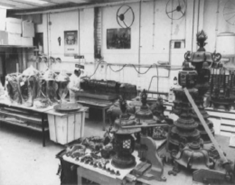 fig. 5
Bronzes in the conservation studio of Evert Moll, Central Laboratory, Amsterdam, 1995 state had been wise to accept the gift under such stringent conditions back in 1903. He questioned the appeal of ‘frozen’ institutions, ‘where corn and chaff are quite often exhibited alongside each other, and where the design and the arrangement no longer meet demands imposed at a later date. It is, however, true that these museums provide a striking and often fascinating picture of the ideas and tastes of collectors of a bygone age, but one still wonders whether the authorities, national or municipal, are acting responsibly by resigning themselves to financial sacrifices year after year in order to run institutions of this kind.’Ga naar voetnoot7 In order to break the deadlock, Hoetink submitted a plan in 1978 ‘that was initially accepted in order to provide the museum with better premises. The building at Plein 1 formerly occupied by the Colonial Ministry was earmarked for the Rijksmuseum H.W. Mesdag. The plans for conversion were already at an advanced stage.’ Architect Gees Dam was asked to produce an initial design,Ga naar voetnoot8 and the directors of N.V. Panorama Mesdag not only backed the director | |
[pagina 22]
| |
 fig. 6
Front room on the ground floor of Mesdag's house, c. 1915 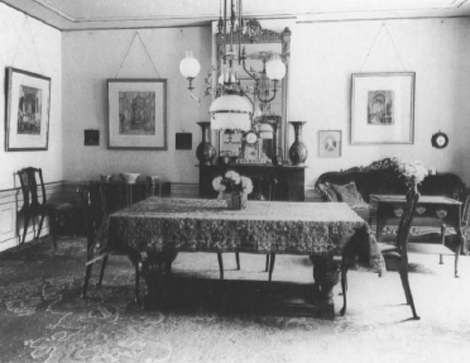 fig. 7
Back room on the ground floor of Mesdag's house, c. 1915 | |
[pagina 23]
| |
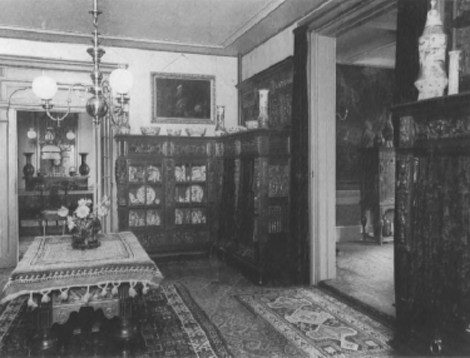 fig. 8
Room on the ground floor of Mesdag's house, c. 1915 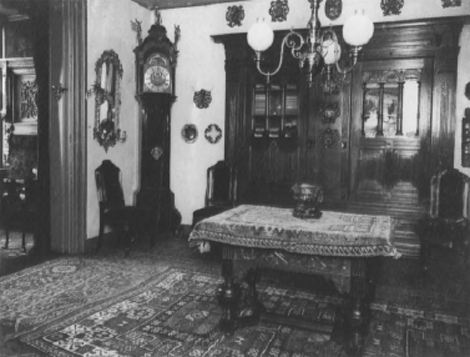 fig. 9
Room on the ground floor of Mesdag's house, c 1915 | |
[pagina 24]
| |
 fig. 10
Front room on the first floor of Mesdag's house, c. 1915 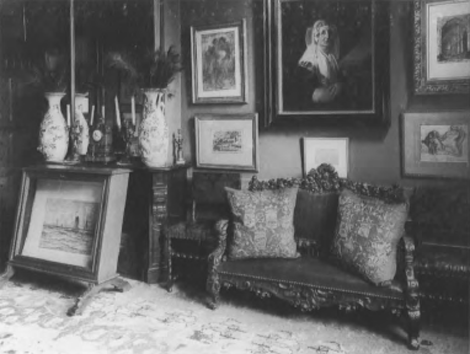 fig. 11
Room facing the garden in Mesdag's house, c. 1915 | |
[pagina 25]
| |
 fig. 12
Back room on the first floor of Mesdag's house, c. 1915  fig. 13
Mesdag's studio, c. 1915 figs. 6-13 Amsterdam, Van Gogh Museum, Museum Mesdag Archive | |
[pagina 26]
| |
but even described his proposal as ‘decidedly attractive.’Ga naar voetnoot9 The building would not only house the Mesdag Collection but would serve as an annex for the Mauritshuis, and would also have a modern conservation studio, reserves, educational facilities and a coffee shop. In the end, though, the Dutch parliament decided that it wanted the building for itself. On 1 October 1980, Hoetink suggested the alternative of 34 Lange Voorhout, which was about to be vacated by the Royal Library.Ga naar voetnoot10 The uncertainty surrounding the future of the Museum Mesdag was to last until 1990. It had gradually become enveloped in a sense of crisis, and its position became very shaky indeed in the 1980s. At that time the Ministry of Welfare, Health and Cultural Affairs began re-assessing its policy with a discussion of (and criteria for) ‘museums of national importance,’ in order to identify museums that should be the responsibility of the state and those that should not. It was felt that the museum had too narrow a base, and it was suggested that it be transferred to a lower tier of government. Director T. Meijer, of the ministry's Museums, Monuments and Archives Directorate, did consider the collection to be of a ‘high quality,’ but, as he stated in a letter to the Panorama board of 4 December 1984, ‘as a result of its restriction to the Hague School and a number of related French paintings, it covers too narrow a theme for it to continue as an independent museum of national importance.’ The ministry was heavily in favour of transferring it to the Hague municipality, ‘in some form or other.’ Discussions to this end were held with the directors of the Panorama Mesdag, and The Hague's Gemeentemuseum was sounded out. In a report of 1919, the National Museums Commission had already come to the conclusion that it might be better if the Museum Mesdag ‘freed of overly restrictive conditions, could be merged with the municipal collection.’ Article 4 of the deed of gift did, in principle, allow for the possibility of moving the museum to another location within The Hague, under certain circumstances. ‘If, as a result of compulsory purchase of the donated immoveable property in the public interest, or for any other cause arising from force majeure that makes it impossible to continue meeting the above conditions, the state shall retain its rights to the gift but shall be obliged to transfer the art collection, at its own cost, to another, suitable location within the municipality of The Hague, and to keep it in being as a museum.’Ga naar voetnoot11 In early 1985 a number of alternative locations for the Museum Mesdag were again proposed: the Johan de Witt House on 14 Kneuterdijk and 15 Lange Vijverberg, Lange Voorhout Palace, as well as transfer to the Gemeentemuseum. A straight swap between the state and the municipality of the Museum Mesdag in exchange for the Museum Bredius was also mooted. It turned out, however, that the Gemeentemuseum was only interested in a few top works from the Mesdag collection. In the meantime, all sorts of other options were circulating in The Hague. Partly as a result of the international success of the Hague School exhibition in 1983,Ga naar voetnoot12 it was argued that there should be a separate museum devoted to that school, in which the Museum Mesdag might have a part to play. It was even suggested that both the Panorama and the Museum Mesdag should be moved to the boulevard at the seaside resort of Scheveningen, where they could serve as a tourist attraction. Not surprisingly, the people of The Hague were beginning to get worried. In an advisory note of 16 August 1985, the National Museums Commission argued that the collection should be kept intact as a national museum. The Ministry of Culture did not immediately agree, and continued negotiations with the municipality of The Hague. The idea now was to transfer the collection to the municipality and to house it and the equally moribund Museum Bredius in Lange Voorhout Palace. This torpedoed a final initiative by Hoetink to make room for the Museum Mesdag in the Johan de Witt House, which was nearer to the centre of the city, even though that proposal, too, was backed by the board of the Panorama Mesdag. When Hoetink, as director, was then excluded from the negotiations with the municipality, the joint directors of the country's national museums issued a furious protest. In a letter of 24 January 1986 they accused the department of spending its time more on an ad hoc ‘buildings policy’ than on a ‘museum | |
[pagina 27]
| |
policy,’ and roundly condemned ‘the combination of Mesdag and Bredius’ as displaying ‘not the slightest vestige of museological vision.’Ga naar voetnoot13 One of the directors' arguments was that the ministry would ‘lose one of the best trumps [it had] in preparing the policy for the presentation of the 19th century [art].’ And indeed, as it turned out, the ultimate solution for the problems besetting the Museum Mesdag was found within the framework of the discussion on the more focused presentation of this period, along the lines of the recently opened Musée d'Orsay in Paris. Ultimately Holland was not to get a separate museum, but the three great museums on Amsterdam's Museum Square - Rijksmuseum, Van Gogh Museum and Stedelijk Museum - defined their areas of interest more precisely, with the result that the Van Gogh Museum began concentrating specifically on 19th-century art in its international context. As a logical consequence, the Van Gogh Museum took the initiative at the end of 1989 to see whether the Museum Mesdag, which was still threatened with closure, could not be better administered by this national museum in Amsterdam than by the Mauritshuis. One argument was that the Van Gogh Museum covered virtually the same area as the Museum Mesdag - international 19th-century art, with emphasis on France - so that a greater thematic and logistical benefit would accrue from their merger than from that with the Mauritshuis, which focused mainly on the Golden Age of the 17th century. The Van Gogh Museum did insist on a further relaxation of the conditions surrounding the museum's presentation and loans policy. In a memorandum presented by the author in late 1989, which had the support of the board of the Panorama Mesdag, approval was sought for: the presentation of temporary exhibitions in the building; a relaxation of the loans policy; the principle that additions could be made to the collection, provided they were on a modest scale and were in keeping with the specific nature of the Museum Mesdag. On 3 April 1990 the administration of the Museum Mesdag was transferred to the director of the Van Gogh Museum, and when the first national museums became independent on 1 July 1994, the Rijksmuseum Vincent van Gogh and the Rijksmuseum H.W. Mesdag were amalgamated in a new foundation: the Stichting Van Gogh Museum. The two institutions now operate under the shorter names by which they have been known for years: ‘Van Gogh Museum’ and ‘Museum Mesdag.’ There was a stroke of luck in 1991 when two houses beside the Museum Mesdag on the Laan van Meerdervoort, numbers 9 and 11, came up for sale. They were Mesdag's old home and that of his brother-in-law, Sam van Houten (the minister responsible for the Child Employment Act of 1874), and they were bought with funds generated by the successful Van Gogh commemorative year of 1990. This reunification of museum and residence partly compensated for the government's oversight in 1915. The gardens of the three buildings were joined together to create a superb outdoor area. When the administration of the Museum Mesdag was transferred to the Van Gogh Museum, it was also insisted that there should be a realistic prospect of a thorough renovation of the building, the original character of which had been spoiled by ‘modernising’ operations in the three decades from 1950. Because of the museum's uncertain future, very little major maintenance had been carried out over the years. Now that it was to make a fresh start, funds were allocated for a complete renovation in order to restore the building to its original state. The purchase of the adjoining house made it possible to draw up a comprehensive plan aimed at returning the museum building to its former glory as far as possible. Mesdag's residence would contain the new entrance, a storage area, a small reception room and other public facilities. The installation of a lift made the rooms on the first and second floors accessible to the disabled. The addition of Mesdag's house to the complex meant that the demands of the modern age and respect for the museum's historical context now dovetailed. Two Hague Rotary Clubs, ‘Des Indes’ and ‘Lange Voorhout,’ set up a Stichting Woonhuis Mesdag to raise funds for the interior of the new additions to the complex. The fund-raising scheme was launched on 8 November 1991 in the premises of the Westland-Utrecht Hypotheekbank on Lange Voorhout, not far from Mesdag's own Pulchri Studio society. A benefit concert was held on 1 | |
[pagina 28]
| |
 fig. 14
Mesdag's studio, Amsterdam, Van Gogh Museum, Museum Mesdag Archive April 1993, and eventually more than 500,000 guilders were raised for the cause.Ga naar voetnoot14 Rather optimistically, the museum was closed to the public at the beginning of 1992, but unfortunately the renovation programme took longer to get under way than had been planned. An initial, ambitious design by the architect Frank Wintermans was not only much too expensive but was in fact far more radical than necessary. The two complexes were finally linked in a design by Rob Stringa that is as simple as it is effective.Ga naar voetnoot15 While the museum was closed for renovation, large parts of the collection were conserved and restored, partly with funds supplied under the Delta Plan for the Preservation of the Cultural Heritage (fig.5).Ga naar voetnoot16 The bulk of the collections of paintings and ceramics was stored in the Van Gogh Museum, while some of the finest works, like Jozef lsraëls's Alone in the world and Delacroix's Evening of the Battle of Waterloo, were temporarily integrated into the permanent display in Amsterdam. In the summer of 1992 a selection of works from the Museum Mesdag went on show as the Van Gogh Museum's summer exhibition, and at the beginning of 1994 a large number of paintings made a short tour of the museums in Liverpool and Edinburgh under the title ‘Treasures from the Mesdag collection.’ Moreover, for | |
[pagina 29]
| |
five successive years from 1993, selections from the Museum Mesdag played an important part in providing an artistic framework for several Van Gogh presentations in the Seiji Togo Memorial Yasuda Kasai Museum of Art in Tokyo. One result of all these temporary shows was to bring the Mesdag collection to the attention of an international public in a very short space of time. The works were seen by many more people than the total number who had ever seen them in the museum's official home. | |
A period pieceAs the annual reports of the successive directors make abundantly clear, the Museum Mesdag suffered from chronic neglect and poverty. The lack of public interest and shortage of government funding frequently led to inadequate or penny-pinching solutions for the problems it faced, and in the long term it seemed impossible to break the downward spiral. As so often happens, that niggardliness and the vacillation of the administrators - and not forgetting the attitude of the Mesdag family, so often criticised by art historians - in the end actually preserved the character of the museum complex. None of the interventions was so fundamental that it could not be reversed. Only one action was irreversible, and that was the decision to demolish the garden studio that Mesdag had built for his successor Martens. It had been erected on inadequate foundations, with the result that there was serious subsidence over the years, and it was not in itself very distinguished. Attempts to preserve it were accordingly no longer in reasonable proportion to the cost of restoration, and in addition it could not have served a useful public purpose without drastically altering its character. The demolition of the studio and of the very obtrusive 1960s staff residence greatly improved the look of the garden. It was redesigned by the landscape architect Edwin Santhagen and now merges harmoniously with the gardens of the Peace Palace next door. The garden had always been closed to visitors to the museum, but now, weather permitting, it will be open in the spring and summer months. The directors of the Museum Mesdag often complained that the upkeep of the building was being neglected, but it turns out that the paint brushes were not entirely idle in all those decades. Investigation of the paintwork preceding the restoration of the interior revealed numerous layers of colour on the woodwork. It was often possible to establish the date of a particular colour scheme, but inevitably fig. 15
Sunset, sheet from one of Mesdag's sketchbooks, The Hague, Museum Mesdag (on loan from the Rijksdienst Beeldende Kunst, The Hague) some decisions had to be made on a rather arbitrary basis. In order to be as consistent as possible it was decided to make an integral choice of paintwork and wall-coverings for each floor. The wainscotting in some of the rooms was given a wood stain, in mahogany or oak, partly decorated with plain gold borders. This return to the original colour schemes has virtually eliminated the white so beloved of 20th-century museum directors. Even the walls of the staircase are now mustard yellow, and many of the ceilings have the same colour as the wainscotting: green or green-blue. This has resulted in a far more varied and colourful interior than the uniform sea-green of the past few decades. Although a few fragments of the original fabric wall-coverings were discovered, no attempt was made to weave reconstructions of them. Paul den Boer, the restoration | |
[pagina 30]
| |
architect, did succeed in finding existing fabrics which came close to the looks of the originals. The same is true of the choice of materials for the Turkish portières, which now give the doorways in the museum a more festive appearance. Although some of the original portières had survived, they were too fragile to be restored, and merely served a documentary purpose. The original wooden floors were retained almost throughout, although they did require a little repair work. In keeping with the ‘ungarnished chic’ that was so typical of Mesdag, they were simply stained and covered with oriental carpets and runners. A tapestry was woven to a design by T.C.A. Colenbrander for the new ceramics gallery in Mesdag's house. As a consequence, some of the rooms underwent a complete transformation. The large salon on the ground floor, which was turned into a painting gallery around 1960, regained its sumptuous verdure tapestries, whose wooded landscapes echo the garden beyond. The two flower still lifes painted by Jan Mortel in 1705, which had served as overdoors, were reinstalled in their original positions. Two fine tapestries were returned to the first-floor corridor opposite the central room, and on the second floor the three large canvases painted by Mesdag and his wife to block off the windows on the front of the house are back in place. Today's stricter requirements governing the admission of daylight frequently created dilemmas for the restorers. It was decided, for instance, not to install the two skylights that Mesdag had planned for the roof. A number of smaller showcases, modelled on two already in the museum, were made for the display of 19th-century oriental bronze objects in the cabinets facing the windows overlooking the Laan van Meerdervoort. It would have been reckless to continue exhibiting paintings in those rooms because of the sunlight streaming through the windows. The group of oriental bronzes and ceramics is now shown almost in its entirety, and two rooms in Mesdag's adjoining house have been given over to a reconstruction of his studio and a display of Colenbrander ceramics, for which appropriate period showcases were acquired.Ga naar voetnoot17 The opportunity to display a wide range of objets d'art from Mesdag's collection unfortunately only partly compensates for the loss to the presentation of his collection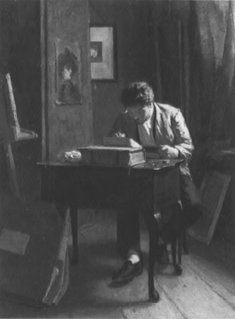 fig. 16
Theo Mesker, The lithographer, 1872, The Hague, Museum Mesdag of drawings and prints. This was not an easy decision, given their considerable importance within the totality of Mesdag's collection, but all the drawings and watercolours he owned had to be withdrawn from the permanent display. They had suffered badly from decades of exposure to light, and it would have been irresponsible to continue showing them. In future they will only be removed from their portfolios for temporary exhibitions. Against this, the museum's collection of paintings has been augmented with a number of appropriate long-term loans and recent purchases, occasionally replacing works by the very artists whose works on paper had to be withdrawn from the display. The Rijksdienst Beeldende Kunst in The Hague loaned several of Mesdag's sketchbooks, and, fully in line with his taste for unfinished works, of art the museum acquired two oil sketches by August Allebé and Balthazar Stroebel, as well as one of the finest works by the Hague Realist Theo Mesker. | |
[pagina 31]
| |
Most of the gallery walls are now covered in fabric for the first time in decades and, in an irony of history, the paintings are now hung very much as they were around 1900, the arrangement having been approximated on the basis of information in old lists and Baedekers.Ga naar voetnoot18 These are all major changes, and they imply that there is no longer an attempt to stress the art-historical connections which so preoccupied successive directors from Steenhoff to De Vries. The key concern in the display is to reflect the taste and views of the collectors. The renovation has brought the museum's presentation full circle, almost 100 years after its creation as a national institution, and has largely restored the layout envisaged by Mesdag and his wife. Although, as we have seen, in 1975 Duparc had no high opinion of such a display ‘where corn and chaff are quite often exhibited alongside each other,’ the present staff of the museum is convinced that this ‘striking and often fascinating picture of the ideas and tastes of collectors of a bygone age’ offers new insights that no other presentation of 19th-century art in the Netherlands can quite provide. The artist's house and museum have been reunited, and the interior has been given its original appearance, not in response to demands made by Mesdag's heirs, but in the awareness that at least as much attention must be paid to the historical aspect of the ensemble as to the supposedly ‘timeless’ appreciation of individual works of art. The renovated Museum Mesdag has now been clearly positioned as a collection museum. Its appeal has been sought in the new and much-appreciated unity of building and objects, which were created for each other as part of a clearly defined vision by the artist-cum-maecenas Mesdag and his wife. As such, in terms of museum history it is no less unique as a 19th-century period piece than The Hague's Prince Willem V Gallery is for the late 18th century and the Kröller-Müller Museum in Otterlo for the Interbellum. It was deliberately decided not to involve the museum further in the march of progress with a blaze of publicity or a ‘lively’ exhibition programme. Its long history demonstrates that there is no great danger of it being inundated by ‘an undue incursion of those who are merely curious,’ as the founders initially feared. In The Hague, which already has a rich and varied offering of museums, the Museum Mesdag fulfils the role of a small jewel whose glory lies in its limitations. Its character is more that of a ‘lieu de silence,’ like the Mauritshuis and the Museum Bredius, than of institutions taking a broader or more topical view like the Gemeentemuseum and the small Palace on Lange Voorhout. Now that the Museum Mesdag has been renovated it is once again ‘of its age,’ but no longer needs to be ‘up to date.’ The modernisations of the past that robbed the borders of the wainscotting of their gleam and the paintings of their gilded frames have been overcome, and prove to have been of less than permanent value. Given the modern appreciation of the individuality of the late 19th century there is no need to worry about Steenhoff's ‘sepulchral nature’ or similar doubts about the viability of a ‘closed’ or ‘frozen’ collection. The national interest appears to be perfectly well served if connoisseurs and art-lovers and, it is to be hoped, the residents of The Hague above all, will rediscover the route to it. Enriched with a marvellous garden, this jewel of a museum is ideally suited to the contemplation of the intimate, emotive art of the Hague and Barbizon Schools that the founders collected with such discrimination. | |
[pagina 33]
| |
Museum Mesdag in Perspective The Museum Mesdag in 1996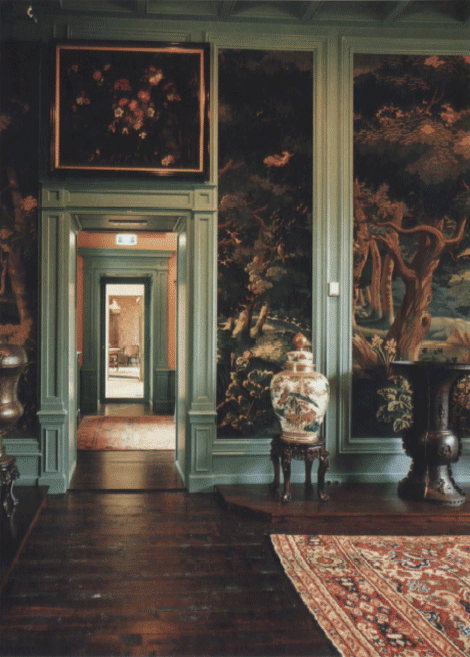 Ground floor centre room
| |
[pagina 34]
| |
 Ground floor centre room
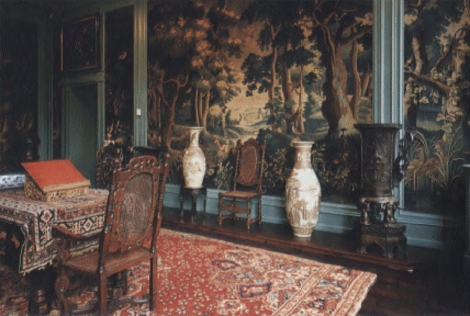 Ground floor centre room
| |
[pagina 35]
| |
 First floor corridor
| |
[pagina 36-37]
| |
 Second floor centre room
| |
[pagina 38]
| |
 Ground floor
| |
[pagina 39]
| |
 First floor centre room
| |
[pagina 40]
| |
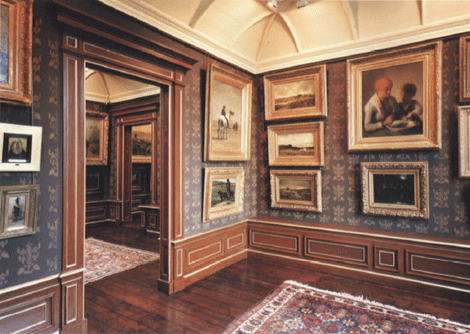 Second floor
|
|

